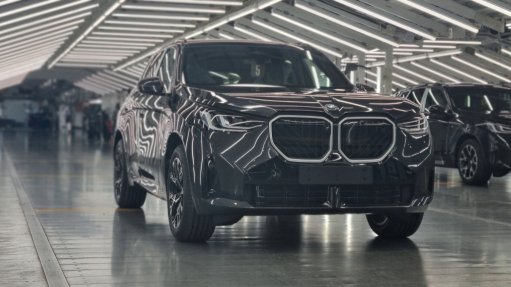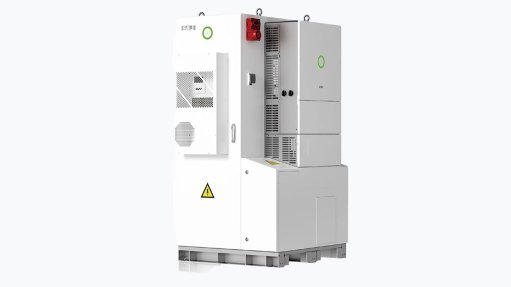SA mulling new ways to unlock much-needed rail infrastructure investment






Traxtion CEO James Holley unpacks his view on private sector investment appetite in South Africa’s freight rail network.
MANGANESE TRAIN A Transnet train carrying manganese to Saldanha
Photo by Creamer Media Chief Photographer Donna Slater
COEGA RAILWAY Transnet must drive better performance across the existing system
Photo by Creamer Media
RAIL INFRASTRUCTURE About two-thirds of South Africa's rail volumes, being bulk freight, are moved over 7% to 15% of the rail network
Photo by Bloomberg
RAIL RECOVERY Transnet has been trying to sustain a network of infrastructure that is too big for its needs
Photo by Creamer Media Chief Photographer Donna Slater
IRON ORE A Transnet iron ore freight train from Sishen to Saldanha
Photo by Creamer Media
Amid existing initiatives to achieve the correct rail access pricing to make it economically viable for private rail operators to invest, provide services and help State-owned transport agency Transnet to pay off its debt, the most important aspect of getting rail transport to operate at the volumes required is to invest in infrastructure.
To increase rail volumes, the country must ensure that Transnet is operating well and it must involve the private sector in commercial opportunities by opening up the network, says South African Presidency project management office head Rudi Dicks.
However, the biggest constraint is the state of infrastructure and South Africa must deal with this.
“Going forward, our ability to address the backlog in infrastructure investments and maintenance will be critical,” he adds.
If rail can be reinvigorated, there are enormous opportunities for Transnet and the country, says rail services company Traxtion CEO and Africa Railway Industry Association chairperson Jamie Holley.
The container corridor line from Johannesburg to Durban is 710 km and has a design transit time of 18 hours using a 50-year-old signalling system. Transnet is using about three days to complete this journey at present.
“Even without changing it to a high-speed line of up to 120 km/h on the straights and 60 km/h around the curves, our modelling has indicated that, by upgrading this line with a modern signalling solution, we can get the transit time down to 9 hours and 52 minutes,” he explains.
If it takes three days to send a train down the line, Transnet can, at best, invoice for services only ten times a month, but getting the transit time to below ten hours can, theoretically, result in invoicing a train twice in a day, or 60 times in a month.
“The same train set can, theoretically, generate six times the revenue. This is the massive opportunity for Transnet and the country.
“Investment in infrastructure is the primary challenge that the country has, but is also a wonderful opportunity for the upliftment of the competitiveness of the upstream economy,” he adds.
Trains & Freight
The condition of infrastructure needs to be addressed, as does the lack of sufficient freight trains.
Third-party access addresses the lack by tapping the private sector to bring train capacity to the network, says Holley.
With about two-thirds of South Africa’s rail volumes being bulk freight moved over 7% to 15% of the rail network, the only viable business case is bulk freight, while new investments in general freight trains are not yet a viable commercial proposition.
“I believe we are going to see investment into the bulk sectors in South Africa, to start with. But, to unlock general freight, we will need trains to turn around quickly, for which we need high-quality infrastructure,” Holley emphasises.
The Africa Railway Industry Association believes that a minimum investment of R150-billion, and probably up to R220-billion, will be required to bring the network back to its design condition.
Transnet has placed the number at about R50-billion over five years, which includes some upgrading to the signalling.
Signalling is critical because the systems are old and it becomes crucial when selling train slots and operating a scheduled rail service, which Transnet has not done for some time, says Transnet chief strategy and planning officer Dr Andrew Shaw.
The agency has an estimated outlier figure of R70-billion over five years, but this is based on it operating a reduced economic rail network.
“We have been trying to sustain a network of infrastructure that is too big for our needs. We are engaging with the Department of Transport to develop a branch-line strategy to allow the private sector to take up what they can,” he adds.
Business Case
South Africa’s growth ambitions depend on it fixing the logistics crisis to unlock the potential of the economy by providing third-party access and thereby expand its trade opportunities, says business organisation Business Unity South Africa CEO-designate Khulekani Mathe.
The business community came in “boots and all” to work alongside government and Transnet colleagues to arrest the decline in the logistics system.
However, suitable private-sector participation (PSP) frameworks are required to stimulate private investment on sound commercial terms over the long term, but these are not yet in place.
Logistics runs on infrastructure, and underinvestment in maintenance and development means that operating conditions only deteriorate, and this has resulted in South Africa’s current challenges.
“If we make the right decisions and make the right investments on logistics, the business community believes that South Africa would grow at 3.3%. This should galvanise us to collectively focus on doing the right things.
“We are encouraged by the prospects of the private sector playing a role in this particular sector. We have moved away from the idea of a monopoly running and dominating our logistics system, and are now looking at using different players to help revitalise, modernise and create greater efficiencies in our system,” Mathe explains.
Supporting Cooperation
Cooperation between the public and private sectors, as well as among different government departments, is necessary to address the rail logistics challenges. The National Logistics Crisis Committee (NLCC) is working with researchers, skilled experts and international teams, says Dicks.
“Central to our delivery methodology is to track progress and ensure high levels of accountability. Transparency and accountability are important because we have to talk about the difficult challenges in the public domain.
“We must be frank and open about the challenges and our outlook. Similar to the electricity crisis, we must say we are currently here and this is what we aim to achieve in six, twelve and eighteen months’ time,” he notes.
This is where milestones and clear roadmaps are important, Dicks adds.
The milestones that the NLCC has reached to date include establishing corridor recovery teams for five main corridors on which chrome, magnetite, manganese, iron-ore and containers are transported, says business organisation Business for South Africa transport and logistics focal area senior executive and NLCC member Ian Bird.
The corridor recovery teams meet twice a month with Transnet executives managing freight rail and port terminals, as well as with Transnet Engineering.
“We have also seconded resources from the private sector to the offices of Transnet Port Terminals and Freight Rail. More recently, partnerships have been used to deal with maintenance, and to carry out independent technical assessments of the condition of the tracks for the coal and iron-ore lines.
There are still some sections to be assessed, but the NLCC and Transnet have a good understanding of the money, timing and work packages required to restore the coal and iron-ore lines to close to their design capacity, Bird adds.
An important milestone that was reached in September is the understanding among business, the NLCC and the Department of Transport of what is required to drive economic growth and what the required volumes are, albeit with private companies or Transnet operating the trains.
“We have coalesced around 250-million tons that need to be moved by rail,” says Bird.
Meanwhile, Transnet has substantial debt of more than R150-billion, and debt repayments constitute a substantial portion of its overall costs.
Shaw says this is part of the reason it is struggling, as “it cannot facilitate those debt repayments with the current revenue stream and the current volumes”, adding that a consequence of this is underinvestment in infrastructure.
However, this challenge does present an opportunity to structure carefully designed PSP frameworks as a way of bringing resources back into the system, and increase revenue in such a way that it can help Transnet to pay down its debt, he adds.
Transnet is targeting 170-million tons to be transported by rail this year, although it is 5% below this target.
“If we can get the 250-million tons moving tomorrow, all the train operators, including us and others, will pay track-access charges, which will help to repay investment in the network.
“However, our contribution, at 170-million tons a year, is not sufficient to ensure the network is properly rehabilitated. This is a volumes and economies-of-scale game. The more you can crowd in new operators onto the system – and this is equally true for ports – the better you can repay the debt for the infrastructure,” Shaw elaborates.
South Africa’s main challenge will be to get the system to operate at the maximum economies of scale to effectively and sustainably compete and provide services.
Transnet must continue to work closely with customers to “get the recovery and stabilisation right” to drive better performance across the existing system, in addition to also accelerating the PSP process to achieve the volumes the country requires, he says.
Article Enquiry
Email Article
Save Article
Feedback
To advertise email advertising@creamermedia.co.za or click here
Comments
Announcements
What's On
Subscribe to improve your user experience...
Option 1 (equivalent of R125 a month):
Receive a weekly copy of Creamer Media's Engineering News & Mining Weekly magazine
(print copy for those in South Africa and e-magazine for those outside of South Africa)
Receive daily email newsletters
Access to full search results
Access archive of magazine back copies
Access to Projects in Progress
Access to ONE Research Report of your choice in PDF format
Option 2 (equivalent of R375 a month):
All benefits from Option 1
PLUS
Access to Creamer Media's Research Channel Africa for ALL Research Reports, in PDF format, on various industrial and mining sectors
including Electricity; Water; Energy Transition; Hydrogen; Roads, Rail and Ports; Coal; Gold; Platinum; Battery Metals; etc.
Already a subscriber?
Forgotten your password?
Receive weekly copy of Creamer Media's Engineering News & Mining Weekly magazine (print copy for those in South Africa and e-magazine for those outside of South Africa)
➕
Recieve daily email newsletters
➕
Access to full search results
➕
Access archive of magazine back copies
➕
Access to Projects in Progress
➕
Access to ONE Research Report of your choice in PDF format
RESEARCH CHANNEL AFRICA
R4500 (equivalent of R375 a month)
SUBSCRIBEAll benefits from Option 1
➕
Access to Creamer Media's Research Channel Africa for ALL Research Reports on various industrial and mining sectors, in PDF format, including on:
Electricity
➕
Water
➕
Energy Transition
➕
Hydrogen
➕
Roads, Rail and Ports
➕
Coal
➕
Gold
➕
Platinum
➕
Battery Metals
➕
etc.
Receive all benefits from Option 1 or Option 2 delivered to numerous people at your company
➕
Multiple User names and Passwords for simultaneous log-ins
➕
Intranet integration access to all in your organisation
























